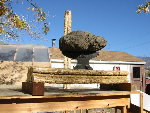
StrawjetA project of the Ashland School
|
|||

 |
|
 |
||||||||||||
ContentsStrawjet ProjectHow it WorksNewsSupport ASETContactHome |
Developing technologies for fabricating load bearing, insulating construction materials from surplus straw.Solutions to the need for better housing in a world of diminishing resources.BackgroundCurrently ASET is focused on finding synergistic solutions to two problems, the need for low cost energy efficient, housing free from environmental toxins, and the need to find better uses for agricultural by products such as straw left over after the harvest of grains. In much of the world, wood is in short supply and forests are threatened. Traditional alternatives such as Adobe which does utilize some straw, are labor intensive and do not stand up well in earthquake prone regions. Straw bale construction is also labor intensive, and requires as significant amount of wood to create rigid load bearing walls. Both construction techniques require wood or some other structural material to hold up the roof. With this in mind David Ward set out to find a solution. Ten years of research and head scratching led to the building of the first prototype of a harvester that could bind straw into a cable, the first stage on the way to a useful product. In late 2001 with the success of the first prototype, David began constructing the current Strawjet prototype, and a the same time gathering the human resources to form the Ashland School of Environmental Technology. By December of 2002, the Strawjet had been completed and field-tested at the Oregon State University Agricultural Experiment Station, and ASET had been established as a non-profit corporation. We believe that the combination of a teaching/ learning environment, and a invention incubator producing real world technologies that contribute to the planet's health is a powerful and cost effective cooperation. The concept of the technologyThe desire to use straw as a building material is as old as the agricultural revolution, but straw based products have always suffered from the apparent lack of strength of the plant itself. Previous technologies from straw bale construction to the recent development of compressed straw-board and straw panels have all begun with crushed, chopped straw. The project is still young, and there are many questions to be answered. We are actively experimenting with binding agents for the straw, and working with systems to maintain the optimal moisture content though the binding process. We are also experimenting with other fibers such as Jerusalem Artichoke, teasel and bamboo.
The ultimate best use of the products have yet to be determined. As with a wooden 2x4, there is a multiplicity of options. Panels and beams come to mind immediately, but there are possibilities that we have just begun to explore such as forming curved members to make arches and domes. The true significance of this technology is the universal availability of straw on a continuously renewable basis. Most other building materials such as, cement, steel, wood, and glass, are associated with significant environmental costs related to their extraction, manufacture or harvest. Straw on the other hand is often considered a waste product and a nuisance, and being a by product of raising crops for human food does not place any additional burden on the environment. The resulting buildings would provide better insulation and be better able to withstand stresses resulting from earthquake than the typical brick and mortar construction used in the developing world. Converting straw to a building material would save resources, provide the farmer with another source of income, and for every ton of straw preserved in this fashion approximately 894 lbs. of carbon would be sequestered for the lifetime of the building. |
|||||||||